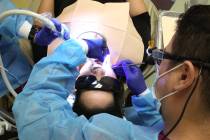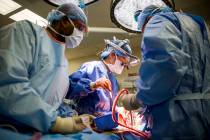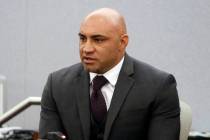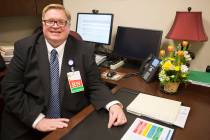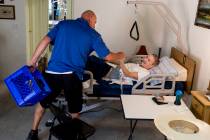UMC leader hopes health care law replacement doesn’t swell uninsured ranks

In February, University Medical Center received the Nevada Taxpayers Association’s 2016 Cashman Good Government Award for turning yearly deficits as high as $100 million into a profit of $42 million.
So our concerns about the Las Vegas Valley’s public safety net hospital, one that Clark County Commissioner Steve Sisolak once said might have to be closed because of its financial problems, are over. Right?
Wrong.
Even ever-optimistic CEO Mason VanHouweling — standing in a monsoon, he probably would talk about the sunshine just around the corner — admits UMC could again become appreciably dependent on the county for funding if Republican legislation to repeal and replace the Affordable Care Act has the effect some analyses predict.
None of the forecasts were more full of gloom and doom than the one presented Monday by the Congressional Budget Office.
Should the legislation get passed — with federal funding for expanded Medicaid coverage rolled back — the CBO predicted 24 million Americans would lose their insurance by 2026.
Couple that forecast with what the Center of Budget and Policy Priorities has predicted for Nevada — 370,000 Nevadans could lose health insurance by 2020 — and the Republican plan to repeal Obamacare doesn’t seem like a positive for UMC.
“About 85 percent of our patients now have insurance,” VanHouweling said. “If it (the Affordable Care Act) goes away or is greatly reduced, there has to be more dependency on the county. In 2012, only 65 percent of our patients had insurance.”
In 2011-12, UMC lost around $70 million because patients were often treated in the emergency room, running up bills they could never pay.
Nevada Gov. Brian Sandoval was the nation’s first Republican governor to expand Medicaid under the Affordable Care Act. The federal government paid, for the first few years, the entire cost of Medicaid coverage for adults without children who met income eligibility requirements.
The state’s Medicaid rolls jumped to more than 630,000, many of them “newly eligibles.”
How many the state could pay for largely on its own isn’t clear.
Eileen Raney, who had a long career as an executive with Deloitte and Touche and serves on UMC’s advisory board, said the hospital would need a subsidy if UMC’s rate of insured patients again dropped to 65 percent.
And that’s despite the hospital having increased market share by 4.7 percent. It has generated a nearly $5 million increase in net revenue in the third quarter 2016 compared with the same period in 2015.
Last year, when UMC first finished in the black — there was a $32 million profit — new contracts had been hammered out that finally got insurers to match reimbursement rates paid to other hospitals. Daily surgical volumes doubled.
Raney said it’s possible private insured admissions will increase as faculty members at the new UNLV medical school admit patients at UMC, which has invested in the latest surgical technology.
UMC advisory board Chairman John O’Reilly remains positive about the final repeal and replacement plan.
“I’m hopeful they’ll eventually see it from a patient and health care provider focus and get it to something tolerable for everyone,” he said. “It would be most unfortunate if we went back to huge numbers of uninsured.”
Paul Harasim’s column runs Sunday, Tuesday and Friday in the Nevada section and Monday in the Health section. Contact him at pharasim@reviewjournal.com or 702-387-5273. Follow @paulharasim on Twitter.




